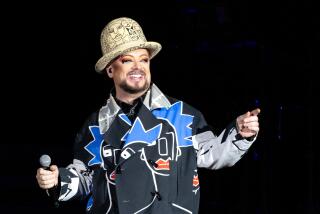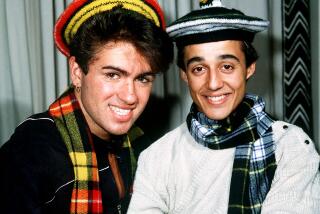POP MUSIC REVIEW : Boy George Ends 4-Year Exile at Hollenbeck Center Benefit
- Share via
The annual benefit concert for the Latino community’s Hollenbeck Youth Center on Wednesday at the Wilshire Theatre concluded with Englishman Boy George singing a new song he wrote in India, backed by members of a Los Angeles Hare Krishna temple.
Following emcee Apollonia’s declaration that “Jesus is my homeboy” and preceding Mayor Bradley’s announcement of Saudi Arabia’s $5,000 donation to the East L.A. facility, it added up to an international patchwork. A real Culture Club, if you will.
Thus did Boy George officially, if somewhat strangely, end an exile that began with a series of drug arrests in London four years ago.
His first American concert since his defunct band Culture Club’s last swing in 1985 was not part of a high-profile tour behind a new album. Instead, it was an isolated appearance in which he was backed mostly by taped instrumental tracks, closing a program of amateur singers and dancers, several comedians, a string of celebrity hosts, veteran rock group Tierra, singer-actress Maria Conchita Alonso and a Filipino version of New Kids on the Block.
An odd setting for a man who dominated the pop world during Culture Club’s early-’80s heyday with his hit records and his flamboyant, androgynous image. The singer’s management says he made the trip solely to support the Hollenbeck Center, whose efforts to turn youths’ lives around he appreciates after going through his own rehabilitation. At the same time, a strategy-minded observer could say it provided an opportunity for him to get his feet wet before an American audience in a relatively low-pressure situation.
When he took the stage, George seemed disconcerted by onstage sound problems, though his singing sounded fine out front. But as he settled in, he began to emanate the peculiar charisma of his prime times. Never one to score with flash and intensity, Boy George instead counts on a flowing, almost gawky brand of body language whose message of defiant individuality is a key ingredient in his bond with his fans.
That following may be down to a hard core of loyalists after his personal problems and commercial decline (his two post-Culture Club albums were commercial failures), and those fans mingled with the Hollenbeck supporters at the Wilshire to form an audience whose sentiments were divided between curiosity and adulation.
Wearing a metallic tunic, black hat and vest, George took advantage of the small-theater setting to establish an intimacy and to sing with more ease and expression than he could on Culture Club’s big-hall, big-deal tours. He lost momentum when he turned the stage over to Kinky, an Englishwoman who records for his More Protein record label. She offered some rapid-fire, Jamaican-style rapping and berated the audience for not standing up.
When George returned, he provided needed spontaneity by introducing Culture Club keyboardist Roy Hay, who backed him on a sublimely sung rendition of the group’s ballad “Victims.” Bringing out two unintroduced guitarists, George referred to recent David Bowie-Mick Jagger scandal-sheet revelations by way of introducing the Stones/Willie Dixon blues classic “Little Red Rooster.”
Finally playful, at ease and singing with the unforced, dusky naturalism that was his trademark, the Karma Chameleon seemed to have crossed a threshold, and it gave the folky, hippie, Hare Krishna hymn that capped the performance a genuine radiance.
More to Read
The biggest entertainment stories
Get our big stories about Hollywood, film, television, music, arts, culture and more right in your inbox as soon as they publish.
You may occasionally receive promotional content from the Los Angeles Times.










